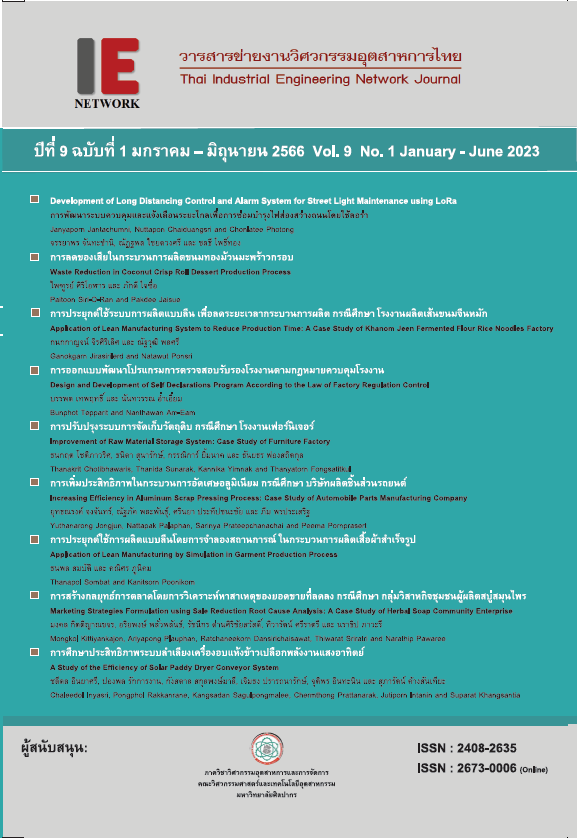Increasing Efficiency in Aluminum Scrap Pressing Process: Case Study of Automobile Parts Manufacturing Company
Main Article Content
Abstract
The sample company produces parts for numerous top automakers, which results in the formation of a large number of metal scraps, particularly aluminum scraps. The goal of this study is to use compactor-based pelletizing to boost the effectiveness of managing aluminum scrap from the manufacturing process. Although it was discovered that the compactor can compress aluminum scrap up to 1,440 kg in 8 hours of normal operation, at the moment the machine can only do so an average of 266 kg every day. 18.47% of the maximal compression effectiveness was represented by this factor. The extruded aluminum lumps' sizes and weights have been observed to vary. The average bale weight for the lightest metal is 0.37 kg. The compactor's effectiveness, however, allows for up to 2 kg of compression per bale. To monitor the actual workplace, the researcher makes use of the concept, ‘3 GEN’. The actual production procedure and details on actual issues that arise. The extruded aluminum lumps were discovered to have 3 sizes of thickness: 1.5-2.5 centimeters, 4-6 centimeters, and 7-10 centimeters. Utilizing the Why-Why Analysis of the issue, stakeholders engage in brainstorming. The shaping of the scrap was discovered to have a direct impact on the shape and weight of the extruded aluminum lump. If the chips are large, the aluminum lumps are short and lightweight but if the crumb is small, the aluminum lump will be long and heavyweight. Therefore, in order to save time and prevent staff fatigue, aluminum scraps are offered to be shred to the same size before being imported into the compactor via a conveyor system. These remedial instructions are then developed using the 5W1H questioning method. The results of the improvements showed that an average weight gain of 1.86 kg per bale, or 93.00% of the press's efficiency, could be achieved for the lightest aluminum bales. During 8 hours of regular operation, an average of 1,339 kg of aluminum scrap may be compressed, indicating 93.00%, an increase of 74.53% over the compression efficiency prior to improvement, and an increase of 39,693 baht per day, or 402%, in sales value from 9,857 to 49,550 baht.
Article Details

This work is licensed under a Creative Commons Attribution-NonCommercial-NoDerivatives 4.0 International License.
บทความ ข้อมูล เนื้อหา รูปภาพ ฯลฯ ที่ได้รับการตีพิมพ์ในวารสารฯ ถือเป็นลิขสิทธิ์ของวารสารฯ หากบุคคลหรือหน่วยงานใดต้องการนำทั้งหมดหรือส่วนหนึ่งส่วนใดไปเผยแพร่ต่อหรือเพื่อกระทำการใดๆ จะได้รับอนุญาต แต่ห้ามนำไปใช้เพื่่อประโยชน์ทางธุรกิจ และห้ามดัดแปลง
References
อภิชัย จินดารักษ์. “แนวทางการบริหารจัดการเศษวัสดุโลหะ: กรณีศึกษาผู้ผลิตเครื่องยนต์ดีเซล” วิทยานิพนธ์วิทยาศาสตรมหาบัณฑิต, สาขาวิชาการจัดการโลจิสติกส์และโซ่อุปทาน คณะโลจิสติกส์, มหาวิทยาลัยบูรพา, 2559.
ปฐมพงษ์ หอมศรี และ จักรพรรณ คงธนะ. 2555.การเพิ่มประสิทธิภาพการผลิตโดยใช้แนวคิดการผลิตแบบลีน: กรณีศึกษาโรงงานผลิตปั๊มน้ำรถยนต์. Kasem Bundit Engineering Journal Vol.2 No.2 (July - December 2012): 40-62
ศรินยา ประทีปชนะชัย และภีม พรประเสริฐ. “การลดของเสียในกระบวนการเย็บเบาะรถยนต์: กรณีศึกษาบริษัทผลิตเบาะรถยนต์,” การประชุมวิชาการราชมงคลด้านเทคโนโลยีการผลิตและการจัดการ, หน้า 10-16, 2563.
รื่นฤดี โยธาคุณ, วรรณกร นามนู, สุพรรณี อึ้งปัญสัตวงศ์, การลดความสูญเสีย 7 ลักษณะในโรงงานอุตสาหกรรม, มหาวิทยาลัยขอนแก่น, หน้า 1-10, 2560.
สุพัฒตรา เกษราพงศ์ และคณะ. “การลดของเสียในกระบวนการผลิตท่อไอเสียรถจักรยานยนต์,” งานประชุมวิชาการข่ายงานวิศวกรรมอุตสาหการ ประจำปี 2555, หน้า 105-112, 2555.
ยุทธณรงค์ จงจันทร์ และคณะ, “การเพิ่มผลผลิตในกระบวนการผลิตแป้งตลับด้วยเทคนิคการออกแบบอุปกรณ์จับยึด,” การประชุมวิชาการข่ายงานวิศวกรรมอุตสาหการ ประจำปี 2559, หน้า 76-85, 2559.
มารุต แร่มี และธีระพงศ์ เซ่ซัง. “การเพิ่มประสิทธิภาพกระบวนการผลิตด้วยเทคนิคของลีน: กรณีศึกษากระบวนการผลิตอิฐบล็อก.” การประชุมวิชาการระดับชาติมหาวิยาลัยเทคโนโลยีราชมงคลรัตนโกสินทร์ ครั้งที่ 3, หน้า 18-23, 2561.
วิศรุต ถวิลวงศ์สุริยะ และคณะ. 2558. การเพิ่มประสิทธิภาพในการผลิตสินค้าแผ่นแปะกระเป๋า 7-ELEVEN.Kasem Bundit Engineering Journal Vol.5 No.2 (July - December 2015): 186-198


